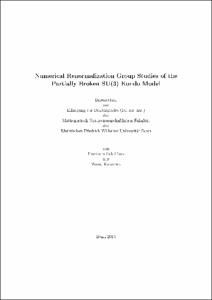Numerical Renormalization Group Studies of the Partially Broken SU(3) Kondo Model

Numerical Renormalization Group Studies of the Partially Broken SU(3) Kondo Model

| dc.contributor.advisor | Kroha, Johann | |
| dc.contributor.author | Fuh Chuo, Evaristus | |
| dc.date.accessioned | 2020-04-18T20:09:16Z | |
| dc.date.available | 2020-04-18T20:09:16Z | |
| dc.date.issued | 29.05.2013 | |
| dc.identifier.uri | https://hdl.handle.net/20.500.11811/5682 | |
| dc.description.abstract | The two-channel Kondo (2CK) effect with its exotic ground state properties has remained difficult to realize in physical systems. At low energies, a quantum impurity with orbital degree of freedom, like a proton bound in an interstitial lattice space, comprises a 3-level system with a unique ground state and (at least) doubly degenerate rotational excitations with excitation energy $Delta_0$. When immersed in a metal, electronic angular momentum scattering induces transitions between any two of these levels (couplings $J$), while the electron spin is conserved. We show by extensive numerical renormalization group (NRG) calculations that without fine-tuning of parameters this system exhibits a 2CK fixed point, due to Kondo correlations in the excited-state doublet whose degeneracy is stabilized by the host lattice parity, while the channel symmetry (electron spin) is guaranteed by time reversal symmetry. We find a pronounced plateau in the entropy at $S(T_K < T < Delta_0) = k_B ln 2$ between the high-$T$ value, $S(T gg Delta_0) = k_B ln 3$, and the 2CK ground state value, $S(0) = k_B lnsqrt{2}$. This indicates a downward renormalization of the doublet below the non-interacting ground state, thus realizing the 2CK fixed point, in agreement with earlier conjectures. We mapped out the phase diagram of the model in the $J-Delta_0$ plane. The Kondo temperature $T_K$ shows non-monotonic $J$-dependence, characteristic for 2CK systems.newline indent Beside the two-channel Kondo effect of the model, we also study the single-channel version, which is realized by applying a strong magnetic field to the conduction band electrons so that their degeneracy is lifted and consequently having only one kind of electrons scattering off the impurity. This single-channel case is easier to analyze since the Hilbert space is not as large as that of the 2CK. We equally find a downward renormalization of the excited state energy by the Kondo correlations in the SU(2) doublet. In a wide range of parameter values this stabilizes the single-channel Kondo fixed point and a phase diagram is also mapped out for the model. In the single-channel version a plateau is found in the entropy at $S(T_K < T < Delta_0) = k_B ln 2$ between high-$T$ value, $S(T gg Delta_0) = k_B ln 3$, and the single-channel Kondo ground state value, $S(0) = k_B ln 1$. | |
| dc.language.iso | eng | |
| dc.rights | In Copyright | |
| dc.rights.uri | http://rightsstatements.org/vocab/InC/1.0/ | |
| dc.subject.ddc | 530 Physik | |
| dc.title | Numerical Renormalization Group Studies of the Partially Broken SU(3) Kondo Model | |
| dc.type | Dissertation oder Habilitation | |
| dc.publisher.name | Universitäts- und Landesbibliothek Bonn | |
| dc.publisher.location | Bonn | |
| dc.rights.accessRights | openAccess | |
| dc.identifier.urn | https://nbn-resolving.org/urn:nbn:de:hbz:5n-32033 | |
| ulbbn.pubtype | Erstveröffentlichung | |
| ulbbnediss.affiliation.name | Rheinische Friedrich-Wilhelms-Universität Bonn | |
| ulbbnediss.affiliation.location | Bonn | |
| ulbbnediss.thesis.level | Dissertation | |
| ulbbnediss.dissID | 3203 | |
| ulbbnediss.date.accepted | 16.04.2013 | |
| ulbbnediss.fakultaet | Mathematisch-Naturwissenschaftliche Fakultät | |
| dc.contributor.coReferee | Bulla, Ralf |
Dateien zu dieser Ressource
Das Dokument erscheint in:
-
E-Dissertationen (4115)




